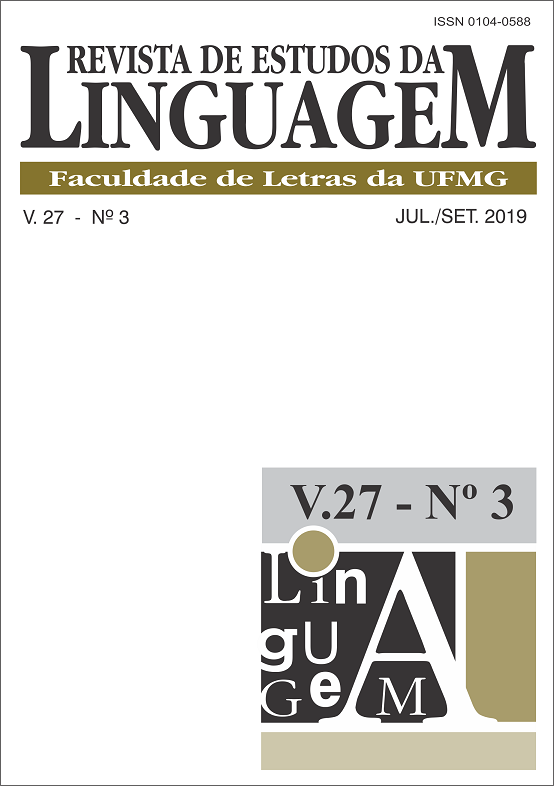Perfilação sistêmica da Popularização da Ciência baseada na argumentação axial / Systemic functional profiles of Popularization of Science based on axial argumentation
DOI:
https://doi.org/10.17851/2237-2083.27.3.1233-1257Keywords:
Abordagens sistêmicas da tradução, Teoria sistêmico-funcional, Argumentação axial, Popularização da ciência.Abstract
Resumo: Esta pesquisa tem como objetivo principal a perfilação sistêmica de textos de Popularização da Ciência por meio de análise de suas escolhas gramaticais para descrever a forma pela qual estes discursos criam variáveis no contexto de cultura (i.e., como esses discursos circulam na sociedade) (MARTIN, 1992). A perfilação sistêmica baseou-se na argumentação axial, mais especificamente nos sistemas de MODO, TRANSITIVIDADE, TEMA e MENSAGEM (Halliday; MATTHIESSEN, 2004). Desta forma, foram analisados através da Teoria Sistêmico-Funcional os níveis de interação e avaliação (metafunção interpessoal), representação da experiência (metafunção ideacional), construção e organização discursiva (metafunção textual) (Halliday, 1967a, b, 1968) nos discursos da Popularização da Ciência em inglês e suas traduções para o português brasileiro. Para realização desta análise foi compilado um corpus de quatro textos baseado na tipologia dos textos no contexto de cultura (MATTHIESSEN et al., 2008), sendo estes: um texto em inglês do website “How Stuff Works” e sua tradução para o português brasileiro e um texto em inglês do programa televisivo “Beakman’s World” e sua tradução para o português brasileiro. Em seguida, os textos foram anotados segundo as metafunções ideacional, interpessoal e textual (Halliday; Matthiessen, 2004) e analisados de forma semiautomática para averiguar as frequências e distribuição funcional nos textos de Popularização da Ciência. A análise dos dados mostrou que os processos mais significativos para a construção do mundo de experiências foram os processos materiais e relacionais atributivos e identificativos. Interpessoalmente, a relação entre produtor e receptor do texto é representada através dos Modos Indicativo Interrogativo, Indicativo Declarativo e Imperativo. Textualmente, os textos são organizados de modo que as mensagens iniciais respondem às questões apresentadas, as continuidades acrescentavam informações às iniciais, as mensagens de descontinuidade: mudança colocavam participantes em evidência e as de descontinuidade: desvio, focalizavam o texto em algum evento em particular.
Palavras-chave: abordagens sistêmicas da tradução; teoria sistêmico-funcional; argumentação axial; popularização da ciência.
Abstract: This research aims at the creation of systemic functional profiles of Popularization of Science texts through the analysis of their grammatical choices. Those systemic functional profiles are based on axial argumentation, more specifically on the systems of MOOD, TRANSITIVITY, THEME and MESSAGE (Halliday; MATTHIESSEN, 2004). In this sense, Popularization of Science texts in English and its translations into Brazilian Portuguese were analyzed according to Systemic Functional Theory on its levels of interaction, evaluation, representation of experience, discourse construction and discursive organization (HALLIDAY, 1967a, b, 1968). Based on the typology of language in the context of culture (MATTHIESSEN et al., 2008), four texts were collected: two texts from the website “How Stuff Works” – the English text and its translation into Brazilian Portuguese, and two texts from the TV program “Beakman’s World” – the English text and its translation into Brazilian Portuguese. These texts were annotated according to the ideational, interpersonal, and textual metafunctions (HALLIDAY; MATTHIESSEN, 2004) and the distribution of functions in Popularization of Science texts were retrieved. Data analysis showed how the texts where recontextualized (HALLIDAY; MARTIN, 1993), creating variables in the context of culture (MARTIN, 1992). The results showed that, ideationally, the most significant processes to represent the world of experiences in the texts were material and relational. Interpersonally, the relation between the producer and the receiver of the text was realized by Indicative Interrogative, Indicative Declarative, and Imperative Moods. Textually, initial messages guide the scientific explanation whereas continuity messages add further information about scientific facts. Discontinuity messages switch focus to specific events of the scientific explanation.
Keywords: systemic approaches to translation; systemic functional theory; axial argumentation; popularization of science.





